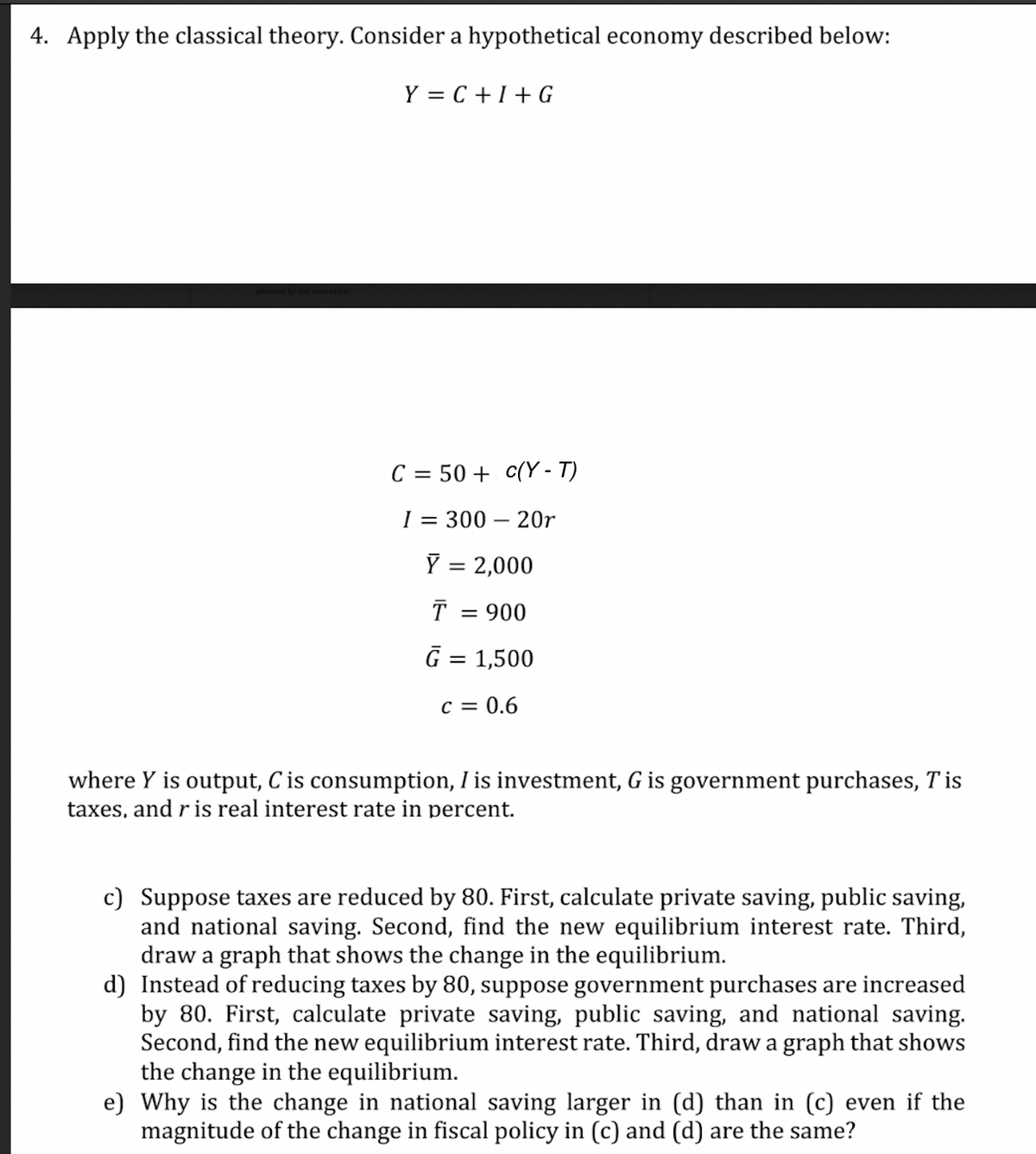4. Apply the classical theory. Consider a hypothetical economy described below: Y=C+I+G C = 50+ c(Y - T) I = 300-20r Y = 2,000 T = 900 G = 1,500
4. Apply the classical theory. Consider a hypothetical economy described below: Y=C+I+G C = 50+ c(Y - T) I = 300-20r Y = 2,000 T = 900 G = 1,500
Principles of Economics (MindTap Course List)
8th Edition
ISBN:9781305585126
Author:N. Gregory Mankiw
Publisher:N. Gregory Mankiw
Chapter36: Six Debates Over Macroeconomic Policy
Section: Chapter Questions
Problem 3PA
Related questions
Question
ANSWER C, D, E FOR UPVOTE

Transcribed Image Text:4. Apply the classical theory. Consider a hypothetical economy described below:
Y=C+I+G
C = 50+ c(Y - T)
I = 300-20r
Y = 2,000
T = 900
G = 1,500
c = 0.6
where Y is output, C is consumption, I is investment, G is government purchases, Tis
taxes, and ris real interest rate in percent.
c) Suppose taxes are reduced by 80. First, calculate private saving, public saving,
and national saving. Second, find the new equilibrium interest rate. Third,
draw a graph that shows the change in the equilibrium.
d) Instead of reducing taxes by 80, suppose government purchases are increased
by 80. First, calculate private saving, public saving, and national saving.
Second, find the new equilibrium interest rate. Third, draw a graph that shows
the change in the equilibrium.
e) Why is the change in national saving larger in (d) than in (c) even if the
magnitude of the change in fiscal policy in (c) and (d) are the same?
Expert Solution
This question has been solved!
Explore an expertly crafted, step-by-step solution for a thorough understanding of key concepts.
Step by step
Solved in 3 steps with 2 images

Knowledge Booster
Learn more about
Need a deep-dive on the concept behind this application? Look no further. Learn more about this topic, economics and related others by exploring similar questions and additional content below.Recommended textbooks for you

Principles of Economics (MindTap Course List)
Economics
ISBN:
9781305585126
Author:
N. Gregory Mankiw
Publisher:
Cengage Learning

Brief Principles of Macroeconomics (MindTap Cours…
Economics
ISBN:
9781337091985
Author:
N. Gregory Mankiw
Publisher:
Cengage Learning

Principles of Macroeconomics (MindTap Course List)
Economics
ISBN:
9781305971509
Author:
N. Gregory Mankiw
Publisher:
Cengage Learning

Principles of Economics (MindTap Course List)
Economics
ISBN:
9781305585126
Author:
N. Gregory Mankiw
Publisher:
Cengage Learning

Brief Principles of Macroeconomics (MindTap Cours…
Economics
ISBN:
9781337091985
Author:
N. Gregory Mankiw
Publisher:
Cengage Learning

Principles of Macroeconomics (MindTap Course List)
Economics
ISBN:
9781305971509
Author:
N. Gregory Mankiw
Publisher:
Cengage Learning

Principles of Economics, 7th Edition (MindTap Cou…
Economics
ISBN:
9781285165875
Author:
N. Gregory Mankiw
Publisher:
Cengage Learning

Principles of Macroeconomics (MindTap Course List)
Economics
ISBN:
9781285165912
Author:
N. Gregory Mankiw
Publisher:
Cengage Learning